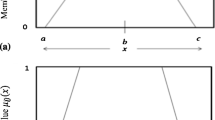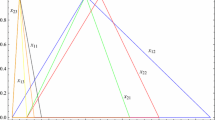Abstract
In this paper, a new computational method is proposed to solve fully fuzzy linear systems (FFLS) of triangular fuzzy numbers based on the computation of row reduced echelon form for solving the crisp linear system of equations. The method is illustrated by solving three numerical examples. As compared to the existing methods, the proposed method is easy to understand and to apply for solving FFLS occurring in real life situations and scientific applications. The primary advantage of the proposed method is that, by using it, the consistency of the FFLS can be checked easily and nature of the solutions of an FFLS can also be obtained which may be unique or infinite.
Similar content being viewed by others
References
Abbasbandy S, Ezzati R, Jafarian A (2006) LU decomposition method for solving fuzzy system of linear equations. Applied Mathematics and Computation 172: 633–643
Abbasbandy S, Jafarian A (2006) Steepest descent method for system of fuzzy linear equations. Applied Mathematics and Computation 175: 823–833
Abbasbandy S, Jafarian A, Ezzati R (2005) Conjugate gradient method for fuzzy symmetric positive-definite system of linear equations. Applied Mathematics and Computation 171: 1184–1191
Allahviranloo T (2004) Numerical methods for fuzzy system of linear equations. Applied Mathematics and Computation 155: 493–502
Allahviranloo T (2004) Successive over relaxation iterative method for fuzzy system of linear equations. Applied Mathematics and Computation 162: 189–196
Allahviranloo T (2005) The adomian decomposition method for fuzzy system of linear equations. Applied Mathematics and Computation 163: 553–563
Buckley J J, Qu Y (1991) Solving systems of linear fuzzy equations. Fuzzy Sets and Systems 43: 33–43
Dehghan M, Hashemi B, Ghatee M (2006) Computational methods for solving fully fuzzy linear systems. Applied Mathematics and Computation 179: 328–343
Dehghan M, Hashemi B (2006) Solution of the fully fuzzy linear system using the decomposition procedure. Applied Mathematics and Computation 182: 1568–1580
Dehghan M, Hashemi B, Ghatee M (2007) Solution of the fully fuzzy linear system using iterative techniques. Chaos, Solitons and Fractals, 34: 316–336
Dubois D, Prade H (1980) Fuzzy sets and systems: Theory and applications. Academic Press, New York
Dubois D, Prade H (1980) Systems of linear fuzzy constraints. Fuzzy Sets and Systems 3: 37–48
Friedman M, Ming M, Kandel A (1998) Fuzzy linear systems. Fuzzy Sets and Systems 96: 201–209
Friedman M, Ming M, Kandel A (2000) Duality in fuzzy linear systems. Fuzzy Sets and Systems 109: 55–58
Gang L H (2010) Generalized fuzzy random set-valued mixed variational inclusions involving random nonlinear (Aω, η ω)-accretive mappings in Banach spaces. J. Nonlinear Sci. Appl. 3: 63–77
Kauffmann A, Gupta M M (1991) Introduction to fuzzy arithmetic: Theory and applications. Van Nostrand Reinhold, New York
Lipschutz S (2005) Shaum’s outline of theory and problems of linear algebra. 3rd edition, McGraw Hill Book Company, New York
Mosleh M, Abbasbandy S, Otadi (2007) Full fuzzy linear systems of the form Ax + b = Cx + d. Proceedings First Joint Congress on Fuzzy and Intelligent Systems
Muzzioli S, Reynaerts H (2006) Fuzzy linear systems of the form A 1 x + b 1 = A 2 x + b 2. Fuzzy Sets and Systems 157: 939–951
Nasseri S H, Sohrabi M, Ardil E (2008) Solving fully fuzzy linear systems by use of a certain decomposition of the coefficient matrix. International Journal of Computational and Mathematical Sciences 2: 140–142
Nasseri S H, Zahmatkesh F (2010) Huang method for solving fully fuzzy linear system of equations. The Journal of Mathematics and Computer Science 1: 1–5
Sun X, Guo S (2009) Solution to general fuzzy linear system and its necessary and sufficient condition. Fuzzy Information and Engineering 3: 317–327
Yin J F, Wang K (2009) Splitting iterative methods for fuzzy system of linear equations. Computational Mathematics and Modeling 20: 326–335
Zadeh L A (1965) Fuzzy sets. Information and Control 8: 338–353
Zhao R, Govind R (1991) Solution of algebraic equations involving generalized fuzzy numbers. Information Sciences 56: 199–243
Author information
Authors and Affiliations
Corresponding authors
About this article
Cite this article
Kumar, A., Neetu & Bansal, A. A new computational method for solving fully fuzzy linear systems of triangular fuzzy numbers. Fuzzy Inf. Eng. 4, 63–73 (2012). https://doi.org/10.1007/s12543-012-0101-5
Received:
Revised:
Accepted:
Published:
Issue Date:
DOI: https://doi.org/10.1007/s12543-012-0101-5




